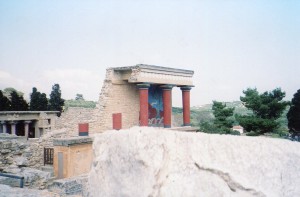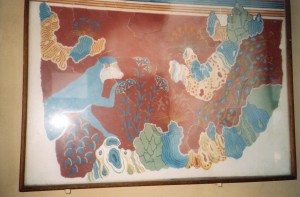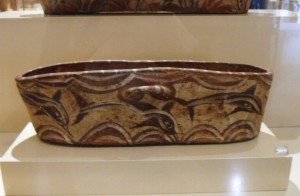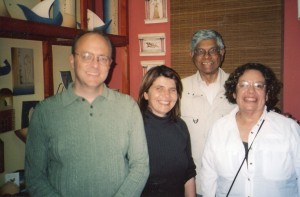The Palace at Knossos can pull you into a different world that you may find more appealing than your own. At least that’s how its excavator Arthur Evans reacted to it, and he pulled $1million from his own wallet to make it more vivid.
Controversies have flared over the authenticity of Evans’ restorations–columns and the painting in the above picture are his creations. Restorations of the old Thai city of Sukhothai by King Mongkut in the nineteenth century have also been questioned. Both men wanted to project ideals of the beginnings of their civilizations. But though the main characteristics of both have been questioned lately, these two idealized sites have usually presided over people’s identities, and given them models for their basic values. So what’s so good about Knossos? Let’s see.
1. The Minoans traded a lot with the Egyptians, but instead of building huge pyramids and temples that dramatically stand out from the land, they erected palaces that gently roll over hilly terrain. Their biggest buildings are in harmony with the surroundings. As I roamed through the palace grounds, I felt that this was a culture that was content to be immersed in nature–it didn’t feel a need to create abstract forms on monumental scales and dominate it through them.
2. Minoans didn’t built large temples. They worshipped on mountain tops, in caves, and within the palaces.
3. Most of their idols were of goddesses, rather than hot blooded male warriors like Zeus. Women were allowed prominent roles in society, and some even joined the contests in which people leaped over a charging bull, somersaulting in midair.
4. Minoan art portrayed people, animals and plant life with loving realism.
5. Many Minoan art forms show things in motion, with swirling lines. This preference contrasts with the static and abstract Greek temples and archaic scultptures. Minoans seem to have seen nature as dynamic. The above picture is of a bathtub–Minoan elites made a lot of them.
6. But the images they created were human-scale, rather than the huge cosmic landscapes that Indian temples embody.
7. The Minoans’ land is also human-scale. It had no single feature to unify it, like Egypt’s Nile or China’s Yellow River. Like Japan, Crete is mountainous, with lots of coastline, and its people created art that didn’t impose grand concepts on nature.
The people I met around Knossos still held these values that focused on enjoying the world around them. The woman on my immediate left owned a local shop, and supplied her visitors with tea and long conversations, just to enjoy the day. We were just browsing, but she turned our stay into a party.
About 10 mom and pop snack shops lined the winding 2 lane road across from the old palace. One was considerably smaller than the others, so I entered it give its owner the business. She was a single woman who looked fifty something. She was still pretty, and must have been stunning while young. I wondered how she ended up there. Her life story didn’t seem to matter as much to her though–I have never seen anyone’s eyes shine more brightly.
The next day, I took a bus to a town south of Knossos called Arhanes. As we passed the palace and shops, I saw her standing outside, looking across the street, over the palace and towards the mountains with an equally happy expression.
Crete had some rough times between its glory days and today. The Ottomans and Venetians took turns imposing their rule. But many of its people can still make enjoying the moment into an art, as the Minoans did. Maybe Evans’ reconstructions were guided by the ancient landscape.





Comments on this entry are closed.